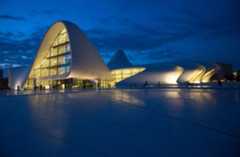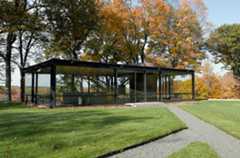Pritzker Prize
Our editors will review what you’ve submitted and determine whether to revise the article.
News•
Pritzker Prize, international award given annually to recognize the contributions of a living architect. It has often been called theNobel Prize ofarchitecture.
The Pritzker Prize was founded in 1979 byJay andCindy Pritzker of Chicago, who funded it as a foundation through their family business, the Hyatt Corporation. The original stated goal of the prize was to pusharchitecture and architects into the public’s awareness and to support the notion that buildings have a real influence on people’s lives. The prize was designed to honor architects for their complete body of built work.
Since 1979, every year an independent jury of about eight people—composed of critics, practicing architects, and patrons of the arts—has decided upon the winner. There are no set terms for jurors, who become part of the jury by invitation and step down when they wish. Notable jurors have included J. Carter Brown, former director of theNational Gallery of Art in Washington, D.C.; Italian businessman Giovanni Agnelli; architectural criticAda Louise Huxtable; art historianKenneth Clark; and major architects such asPhilip Johnson (the first recipient of the prize),Maki Fumihiko,Frank O. Gehry, andCesar Pelli.

Any licensed architect may nominate a candidate by communicating with the executive director of the jury. The director additionally actively seeks outnominations from critics, academics, professionals in related fields, and the jurors. As part of the deliberation process, which takes place at the beginning of the year, jurors visit many buildings by architects under consideration for the prize. This fieldwork is an especially positive aspect of the prize and distinguishes it from other awards that simply rely on photos.
- In full:
- Pritzker Architecture Prize
- Related Topics:
- architecture
- Notable Honorees:
- Zaha Hadid
- I.M. Pei
- Frank Gehry
- Álvaro Siza
- Related Facts And Data:
- Sydney Opera House - Facts
The Pritzker Prize carries a purse of $100,000 and, until 1987, a limited-editionHenry Moore sculpture; this was replaced in subsequent years by a bronze commemorative medal. The prize is presented in a ceremony, usually in May of each year, at an architecturally significant site. On several occasions more than one winner has been chosen, including in 1988 to celebrate the 10th anniversary of the prize and in such years as 2001, 2010, and 2017 to recognize each partner of an architectural firm. Past winners are among the most important figures in late 20th- and early 21st-century architecture. For Pritzker Prize winners,seetable.
| year | name | country* |
|---|---|---|
| *Nationality given is the citizenship of recipient at the time award was made. | ||
| 1979 | Philip C. Johnson | United States |
| 1980 | Luis Barragán | Mexico |
| 1981 | Sir James Stirling | United Kingdom |
| 1982 | Kevin Roche | United States |
| 1983 | I.M. Pei | United States |
| 1984 | Richard Meier | United States |
| 1985 | Hans Hollein | Austria |
| 1986 | Gottfried Böhm | Germany |
| 1987 | Tange Kenzo | Japan |
| 1988 | Gordon Bunshaft | United States |
| Oscar Niemeyer | Brazil | |
| 1989 | Frank O. Gehry | United States |
| 1990 | Aldo Rossi | Italy |
| 1991 | Robert Venturi | United States |
| 1992 | Álvaro Siza | Portugal |
| 1993 | Maki Fumihiko | Japan |
| 1994 | Christian de Portzamparc | France |
| 1995 | Ando Tadao | Japan |
| 1996 | Rafael Moneo | Spain |
| 1997 | Sverre Fehn | Norway |
| 1998 | Renzo Piano | Italy |
| 1999 | Sir Norman Foster | United Kingdom |
| 2000 | Rem Koolhaas | Netherlands |
| 2001 | Jacques Herzog | Switzerland |
| Pierre de Meuron | ||
| 2002 | Glenn Murcutt | Australia |
| 2003 | Jørn Utzon | Denmark |
| 2004 | Zaha Hadid | United Kingdom |
| 2005 | Thom Mayne | United States |
| 2006 | Paulo Mendes da Rocha | Brazil |
| 2007 | Richard Rogers | United Kingdom |
| 2008 | Jean Nouvel | France |
| 2009 | Peter Zumthor | Switzerland |
| 2010 | Kazuyo Sejima | Japan |
| Ryue Nishizawa | ||
| 2011 | Eduardo Souto de Moura | Portugal |
| 2012 | Wang Shu | China |
| 2013 | Toyo Ito | Japan |
| 2014 | Ban Shigeru | Japan |
| 2015 | Frei Otto | Germany |
| 2016 | Alejandro Aravena | Chile |
| 2017 | Rafael Aranda | Spain |
| Carme Pigem | ||
| Ramon Vilalta | ||
| 2018 | Balkrishna Doshi | India |
| 2019 | Isozaki Arata | Japan |
| 2020 | Yvonne Farrell | Ireland |
| Shelley McNamara | ||
| 2021 | Anne Lacaton | France |
| Jean-Philippe Vassal | ||
| 2022 | Francis Kéré | Burkina Faso |
| 2023 | David Chipperfield | United Kingdom |
| 2024 | Riken Yamamoto | Japan |
| 2025 | Liu Jiakun | China |







